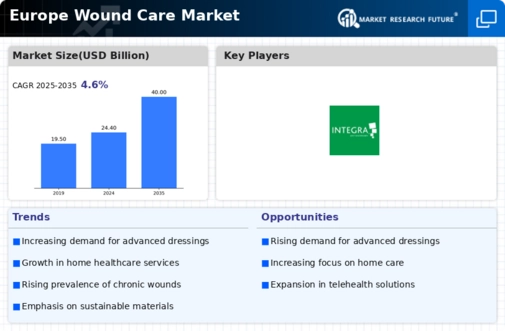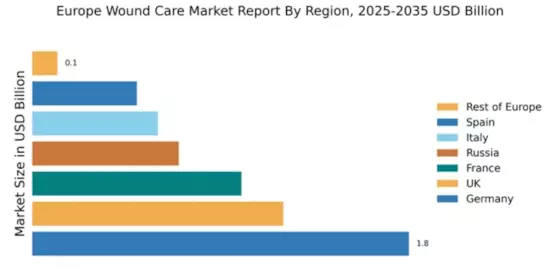Rising Healthcare Expenditure
The increase in healthcare expenditure across Europe is a significant driver for the wound care market. Governments and private sectors are investing more in healthcare infrastructure, which includes wound care services. In 2025, healthcare spending in Europe is projected to reach approximately €2.5 trillion, reflecting a commitment to improving patient care. This financial investment enables healthcare facilities to acquire advanced wound care products and technologies, enhancing treatment options available to patients. Furthermore, as healthcare systems strive to provide high-quality care, the demand for effective wound management solutions is likely to rise, thereby stimulating growth in the wound care market.
Increasing Incidence of Chronic Wounds
The rising prevalence of chronic wounds, such as diabetic ulcers and pressure sores, is a critical driver for the wound care market in Europe. As the population ages, the incidence of conditions that lead to chronic wounds is expected to increase. For instance, it is estimated that around 4.5 million people in Europe suffer from chronic wounds, which significantly burdens healthcare systems. This growing patient population necessitates advanced wound care solutions, thereby propelling market growth. Furthermore, the economic impact of chronic wounds is substantial, with treatment costs reaching approximately €20 billion annually across Europe. This financial strain on healthcare resources underscores the urgent need for effective wound management strategies, driving innovation and investment in the wound care market.
Advancements in Wound Care Technologies
Technological innovations play a pivotal role in shaping the wound care market in Europe. The introduction of advanced wound dressings, such as hydrocolloids and bioactive materials, enhances healing processes and improves patient outcomes. Moreover, the integration of digital health technologies, including telemedicine and mobile health applications, facilitates better monitoring and management of wounds. The European market for wound care technologies is projected to grow at a CAGR of 6.5% over the next five years, reflecting the increasing adoption of these innovations. As healthcare providers seek to optimize treatment protocols and reduce healing times, the demand for cutting-edge technologies in wound care is likely to surge, further driving the market.
Growing Awareness of Wound Care Management
There is a notable increase in awareness regarding effective wound care management among healthcare professionals and patients in Europe. Educational initiatives and training programs aimed at improving knowledge about wound care practices are becoming more prevalent. This heightened awareness is crucial, as it leads to better treatment adherence and improved patient outcomes. The wound care market benefits from this trend, as healthcare providers are more inclined to invest in advanced wound care products and solutions. Additionally, the emphasis on patient education empowers individuals to take an active role in their wound management, potentially reducing complications and healthcare costs. This shift in mindset is expected to contribute positively to the growth of the wound care market.
Aging Population and Associated Health Issues
The aging population in Europe is a crucial factor influencing the wound care market. As individuals age, they become more susceptible to various health issues, including skin fragility and chronic diseases that can lead to wounds. It is estimated that by 2030, over 25% of the European population will be aged 65 and older, which will likely increase the demand for wound care products and services. This demographic shift necessitates a focus on specialized wound management solutions tailored to the needs of older adults. Consequently, the wound care market is expected to expand as healthcare providers seek to address the unique challenges posed by an aging population.


















Leave a Comment